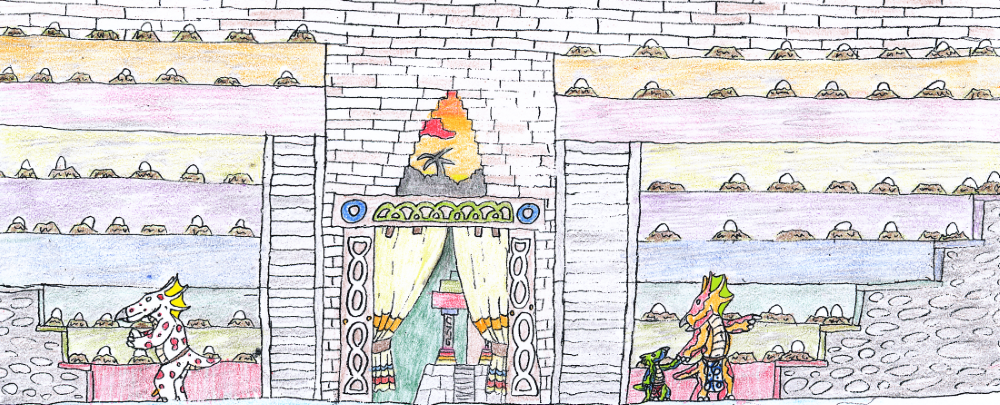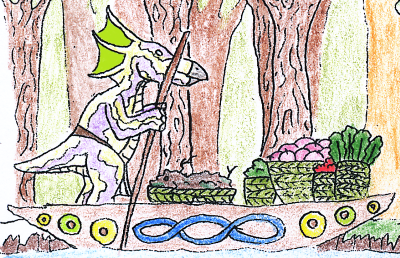Kroks
The Kroks1 are reptilian people who inhabit the Vorran Peninsula, a region isolated from the rest of the Dragonían continent by the Vúrakesen Mountains to the east. They are distantly related to the Exíans of the southeastern Múlíat Mountains.
Kroks have a set mating season each year, outside of which they feel little to no need to procreate, and all the pregnant women lay their eggs at another time of the year. Hatchlings appear a few weeks later.
According to tradition, the Kroks were lead west by a shaman who had foreseen terrible things if they'd linger any more in Kvaror. After following the Vikrú River and then crossing the Vúrakesen Mountains, they settled down on the peninsula (the name Vorran means Myriad Trees) and slowly spread throughout the region as far west as the Virrem Islands.
Initially isolated from the rest of the world, the Kroks made first contact with the Jaarels in 351 b.Dr., which have since been their only connection to the outside world, similarly to the relationship between Minotaurs and Þrihaks on the other side of the continent.
In contrast, gathering places and temples are made of stone or bricks, usually plastered and painted in bright colours on the outside. Golden or gilded rings are often placed on the roofs of temples and hatcheries, which symbolize vúrlú or harmony.
More regional cuisines include vaakría eggs along the southeastern coast, Vlarks around Bay of Lúrrtún, worm-based dishes to the north, and Jaarelo-Krokish fusion cuisine characterized by the use of mushrooms, offal and fat.
The only widespread dietary restriction known to the Kroks is a ban on eating flying creatures, as they are believed to be messengers of the spirits, and even Kroks living among the Jaarels avoid eating bat meat because of this.
Another important aspect of Krokish religion is vúrlú or harmony, which emphasizes that anyone who commits murder or other serious crimes must be exiled to avoid bringing further misfortune to their village.
Appearance and abilities
Kroks are relatively short (little taller than Jaarels), stocky, bipedal reptiles, with short tails, beak-like mouth and three clawed fingers on each hand. At the back of their heads are twin crests of spikes, with thin membranes stretched between, which changes colour depending on the Krok's current mood. Their scales are brightly coloured, and no two Kroks share the exact same markings.Kroks have a set mating season each year, outside of which they feel little to no need to procreate, and all the pregnant women lay their eggs at another time of the year. Hatchlings appear a few weeks later.
History
While the Kroks have lived on Vorran Peninsula for millennia, they are not native to that region, but migrated there from Kvaror, the northwesternmost part of the Múlíat Mountains around 4500 b.Dr. Prior to the migrations, the Kroks were nomads, hunting giant insects and gathering edible plants, at first alongside related reptilian tribes, but these cousins slowly perished as the climate gradually became warmer and more arid.According to tradition, the Kroks were lead west by a shaman who had foreseen terrible things if they'd linger any more in Kvaror. After following the Vikrú River and then crossing the Vúrakesen Mountains, they settled down on the peninsula (the name Vorran means Myriad Trees) and slowly spread throughout the region as far west as the Virrem Islands.
Initially isolated from the rest of the world, the Kroks made first contact with the Jaarels in 351 b.Dr., which have since been their only connection to the outside world, similarly to the relationship between Minotaurs and Þrihaks on the other side of the continent.
Society
The Kroks are divided into fourteen territories, each made up of villages around a gathering place, where villagers come together around the time the women lay their eggs. The eggs are stored in large, circular buildings that act as hatcheries (known as rra), and the people use the time before they hatch to perform a number of rituals, exchange goods and news and overall strengthening the bonds between different villages.Culture
Apparel
Krokish clothing is made of Tree Silk, a soft, thin material made from the sap of Silk Trees, which are endemic to Vorran Peninsula. Kroks wear minimal clothing, usually just a simple loincloth or a cloak, the latter being mostly worn by the elderly.Art
Architecture
Krokish homes are relatively small, consisting of a wooden frame supporting a thatched roof, with walls made of wattle-and-daub, all build upon stone foundations. Entrances are covered by curtains rather than doors to aid ventilation.In contrast, gathering places and temples are made of stone or bricks, usually plastered and painted in bright colours on the outside. Golden or gilded rings are often placed on the roofs of temples and hatcheries, which symbolize vúrlú or harmony.
Cuisine
Traditional Krokish cuisine is divided into a number of regional traditions due to the different environments on the Vorran Peninsula and, more recently, influence from the Jaarels. Nevertheless, there are certain elements found in most culinary traditions there, such as púlraal paste and þvek berries, leafy greens, insects, the meat of enísas, marine and freshwater fish, and certain spices like mnaak and övúb. Eretvóas, rodents brought by early Kroks from Kvaror, were a staple food prior and during the migration to the peninsula, a practice that has since become obscure.More regional cuisines include vaakría eggs along the southeastern coast, Vlarks around Bay of Lúrrtún, worm-based dishes to the north, and Jaarelo-Krokish fusion cuisine characterized by the use of mushrooms, offal and fat.
The only widespread dietary restriction known to the Kroks is a ban on eating flying creatures, as they are believed to be messengers of the spirits, and even Kroks living among the Jaarels avoid eating bat meat because of this.
Language
The Kroks speak a numbers of different languages, commonly referred to as Mlúkrok. They are the only people in western Dragonía who write using an alphabet.Religion
Kroks believe that they were created by spirits who remained in Kvaror, and that Vorran Peninsula is inhabited by different spirits who are considered natives of the land, and only allow the Kroks to continue living there so long as they are shown respect. Knocking on things or clapping is a common way to let the spirits know of ones presence, and they are often offered food at temples to make sure they're satisfied.Another important aspect of Krokish religion is vúrlú or harmony, which emphasizes that anyone who commits murder or other serious crimes must be exiled to avoid bringing further misfortune to their village.
Afterlife
The Kroks believe that when one leaves Avlirrem, world of the living, their soul splits into three parts, all of which initially visit Kvaror. One part stays behind, the second visits Kroks in their dreams to give advice, and the third watches over the hatcheries.1Original icelandic: Krokar, singular: Kroki
Encompassed species
Related Organizations
Languages spoken
Related Locations





Comments